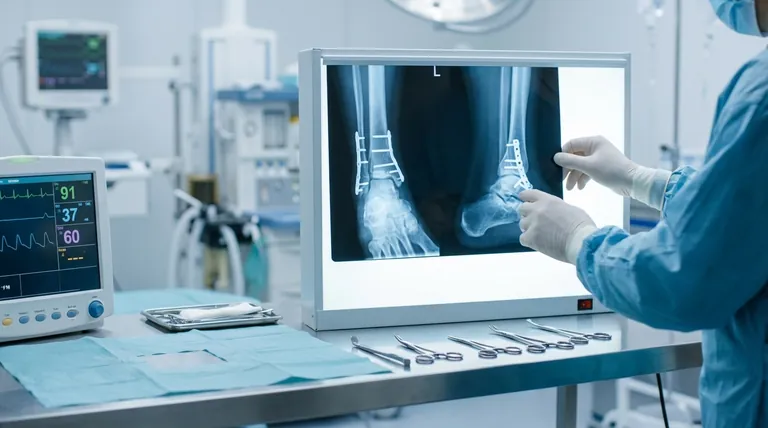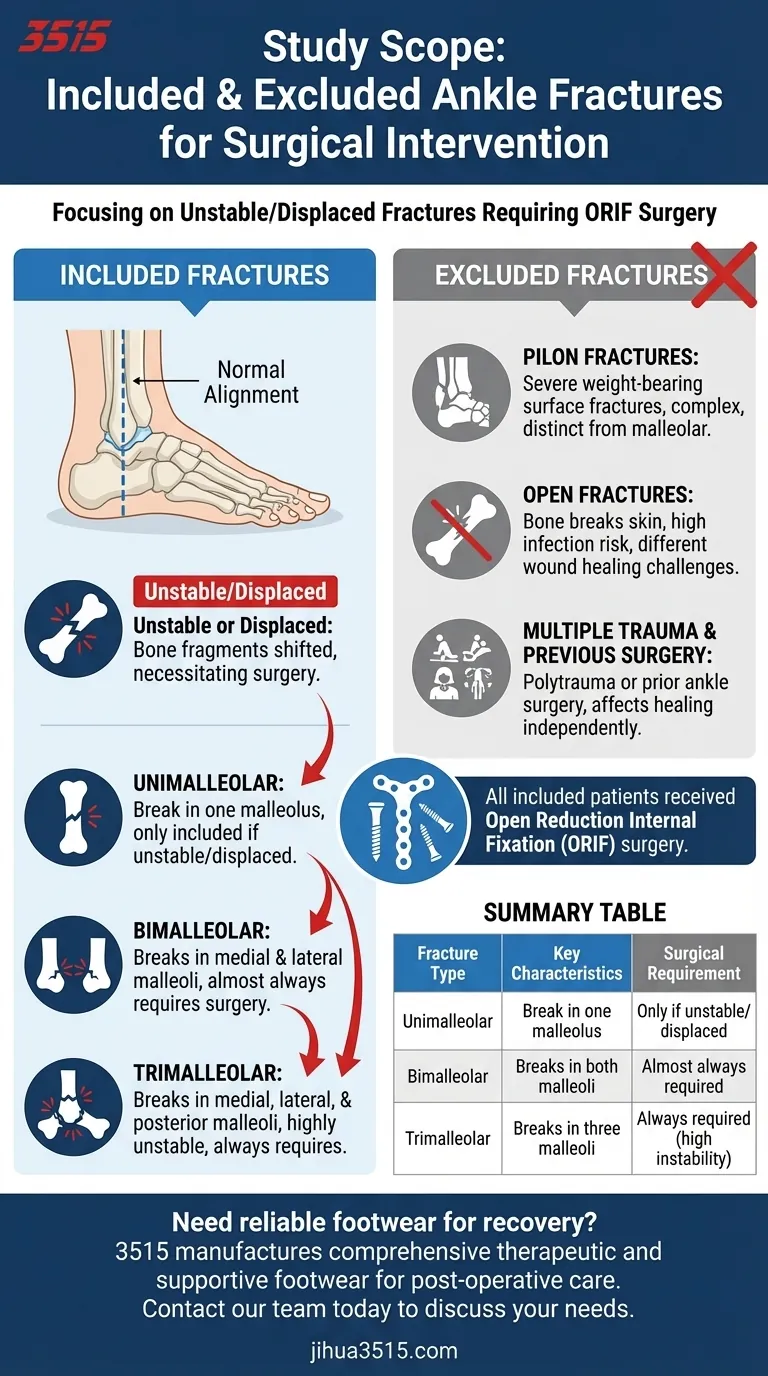The study specifically focused on a distinct subset of ankle injuries requiring surgical intervention. It included patients with displaced or unstable unimalleolar, bimalleolar, and trimalleolar fractures. These are common fracture patterns where the bone fragments have shifted out of their normal alignment.
This study’s patient selection was designed to evaluate a homogenous group of severe but typical ankle fractures treated with surgery, intentionally excluding cases with confounding factors like open wounds or more complex joint involvement.

A Closer Look at the Included Fractures
To understand the study's applicability, it's crucial to examine the specific types of injuries that met the inclusion criteria. The unifying theme is fractures severe enough to require surgical stabilization.
Unstable or Displaced Fractures
This is the core criterion. It means the broken bone pieces were not aligned properly, making the ankle joint unstable. This instability is what necessitates an Open Reduction and Internal Fixation (ORIF) surgery, which every patient in the study received.
Unimalleolar Fractures
This involves a break in a single malleolus, which are the bony prominences on either side of the ankle. While some unimalleolar fractures can be stable, this study only included those that were unstable or displaced.
Bimalleolar Fractures
As the name implies, this is a more significant injury involving breaks in both the medial (inside) and lateral (outside) malleoli. These fractures are inherently unstable and almost always require surgery.
Trimalleolar Fractures
This is the most severe of the included fracture patterns. It involves breaks of the medial malleolus, the lateral malleolus, and the posterior malleolus (the back part of the tibia), making the ankle joint highly unstable.
Understanding the Exclusions: Why Certain Fractures Were Omitted
The exclusion criteria are just as important as the inclusion criteria for defining the study's scope. These patients were omitted to avoid introducing variables that could complicate the results and their interpretation.
Pilon Fractures
These are severe fractures of the weight-bearing surface at the bottom of the tibia. They are fundamentally different from malleolar fractures, often involving more significant cartilage damage and a more complex recovery, which is why they were excluded.
Open Fractures
An open fracture is one where the bone has broken through the skin. This introduces a high risk of infection and different wound-healing challenges, making it a significant confounding factor.
Multiple Trauma and Previous Surgery
Patients with multiple injuries (polytrauma) or who had prior surgery on the same ankle were excluded. These factors can independently affect healing and functional outcomes, making it difficult to isolate the effects of the intervention being studied.
Making the Right Choice for Your Goal
Understanding this patient population is key to applying the study's findings correctly. The results are specific to this surgically treated group.
- If your primary focus is on common, surgically-managed ankle fractures: The study's findings are likely highly relevant for unstable unimalleolar, bimalleolar, and trimalleolar cases.
- If your primary focus is on highly complex articular injuries: Be cautious, as the results do not apply to pilon fractures, open fractures, or patients with multiple traumas.
- If your primary focus is on non-operative fracture management: This study is not applicable, as every included patient underwent ORIF surgery.
By clearly defining its patient cohort, the study provides targeted insights for a specific and common clinical scenario.
Summary Table:
| Fracture Type | Key Characteristics | Surgical Requirement |
|---|---|---|
| Unimalleolar | Break in one malleolus (ankle bone) | Only if unstable or displaced |
| Bimalleolar | Breaks in both medial and lateral malleoli | Almost always required |
| Trimalleolar | Breaks in medial, lateral, and posterior malleoli | Always required due to high instability |
Need reliable footwear for patients recovering from ankle surgery? As a large-scale manufacturer, 3515 produces a comprehensive range of therapeutic and supportive footwear for distributors, brand owners, and bulk clients. Our production capabilities encompass all types of shoes and boots designed for post-operative care and comfort. Contact our team today to discuss your specific needs and volume requirements.
Visual Guide

Related Products
- Wholesale Durable 6-Inch Work Boots | Custom & Private Label Manufacturer
- Durable Leather Work Boots Wholesale Manufacturer & Custom Factory
- Wholesale Slip-On Safety Boots Manufacturer - Custom Puncture-Proof & Steel Toe
- Wholesale Durable Safety Boots | Custom Steel Toe & Puncture-Resistant Manufacturing
- Custom Wholesale Leather Safety Boots Direct Factory Manufacturing
People Also Ask
- Is it normal to wear shoes in the house? A Guide to Hygiene, Comfort & Culture
- What features should you look for in work boots to prevent foot pain? Find Boots That Support You All Day
- Who should wear steel toe work boots? Essential Foot Protection for High-Risk Jobs
- What cultural and environmental considerations are tied to wearing shoes indoors? Balance Hygiene, Tradition, and Foot Health
- What causes blisters in work boots? The Real Culprits Behind Foot Pain














